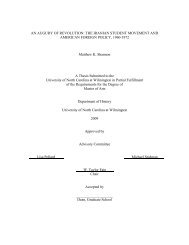HIERARCHAL INDUCTIVE PROCESS MODELING AND ANALYSIS ...
HIERARCHAL INDUCTIVE PROCESS MODELING AND ANALYSIS ...
HIERARCHAL INDUCTIVE PROCESS MODELING AND ANALYSIS ...
Create successful ePaper yourself
Turn your PDF publications into a flip-book with our unique Google optimized e-Paper software.
set of values that respect the constraints and, using the Levenberg-Marquardt<br />
gradient descent method, finds a local optimum. To avoid entrapment in local<br />
minima, the system will restart the parameter estimation from multiple<br />
random points retaining only the parameters that produce the lowest error.<br />
In our experiment we set the number of restarts to 128. This technique has<br />
been found to produce reasonable matches to time series in multiple systems<br />
(Langley et al. 2007).<br />
4. Evaluates the performances of the produced model structures (predicted values)<br />
against the data series (observed values) by calculating the root mean<br />
square error (reMSE); models with the lowest reMSE will be considered best<br />
fit models.<br />
2.1.1 Measure of Fit<br />
As mentioned above, HIPM evaluates and selects the best model structure and set<br />
of parameters according to a fitness measure. The system currently uses the sum<br />
of square error (SSE) to evaluate fitness (Bridewell et al. 2007), which is defined as<br />
follow:<br />
n∑<br />
i=1<br />
SSE(x i , x obs<br />
i ) =<br />
n∑<br />
i=1<br />
m∑<br />
k=1<br />
(x i,k − x obs<br />
i,k ) 2<br />
where x i , . . . , x n are the variables that are being fitted with m observed values for<br />
each. To take into account the modeling of variables of varying scale, the system<br />
uses a relative mean squared error that we define in the following way:<br />
reMSE =<br />
∑ n SSE(x i ,x obs<br />
i )<br />
i=1 s 2 (x obs<br />
i )<br />
nm<br />
Here s 2 (x obs<br />
i ) is the sample variance of the observation for x i . Across this paper<br />
12
















